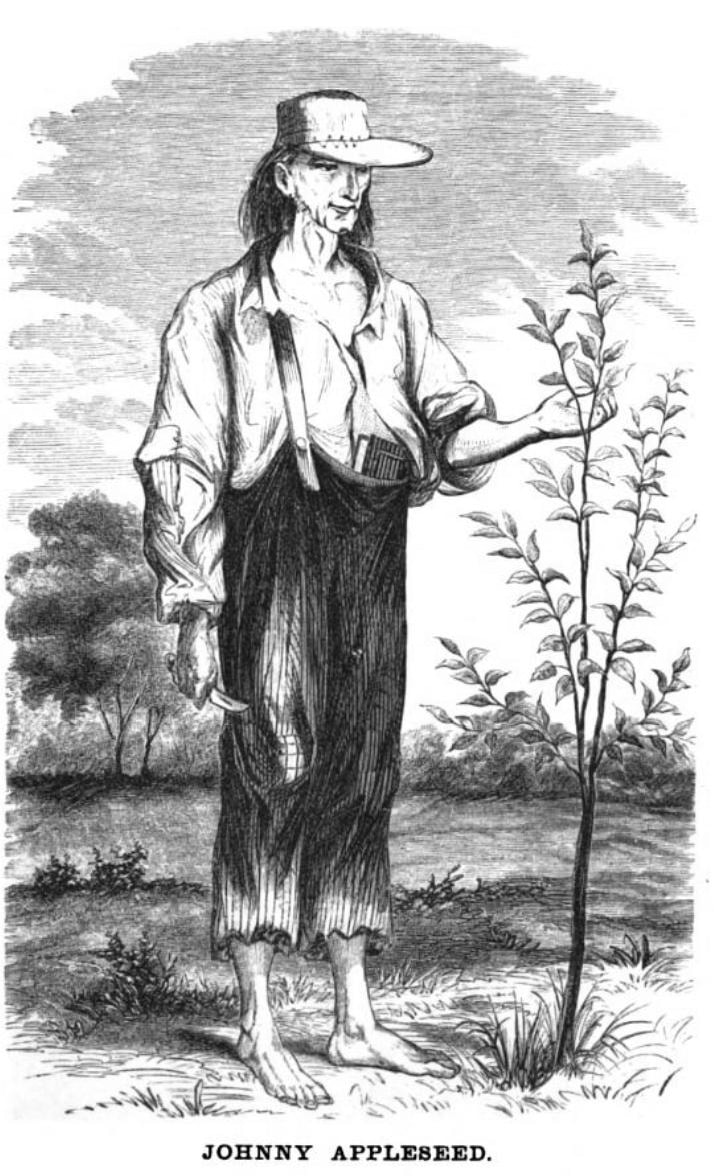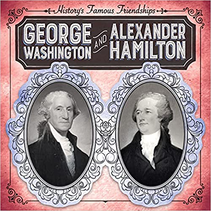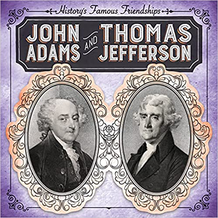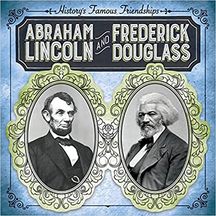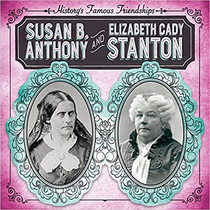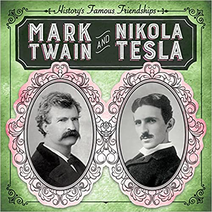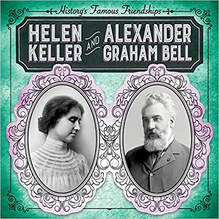Heroes - Lives to Learn From
September
Respect Responsibility Friendship
September
Respect Responsibility Friendship
Johnny Appleseed (John Chapman) (1774-1845)
|
Respect for nature and a sense of responsibility of for those who would follow: those attributes characterize the legendary frontier hero, who planted apple seeds in unsettled lands and cultivated orchards for the next generation.
There is consensus that Johnny Appleseed's real name was John Chapman, but much of his life is surrounded by the legends that began while he was still alive. What do we know for sure? Massachusetts-born John Chapman headed west at age 18, intent on spreading his faith and sowing apple seeds. At that time Pennsylvania, Ohio, Indiana, and Illinois were the frontier and he traveled to all. Johnny impressed everyone he met with his missionary zeal and his enthusiasm for planting apple orchards. (Legend also says that he wore a cooking pot on his head!) In addition to the many orchards he planted in the unsettled Midwest, he left an estate of 1200 acres of nurseries to his sister when he passed away, probably around 1845. Modern biologists laud that he planted from seed rather than grafting. It contributed to biodiversity. As a thankful historian wrote, "So long as his memory lives will a grateful people say: 'He went about doing good.'" The following children's biographies tell his story with verve and charm. |

Johnny Appleseed. Rosemary and Stephen Vincent Benét. Illustrated by S.D. Schindler. Margaret K. McElderry Books, 2001. Respect, Responsibility, Perseverance.
A winsomely-illustrated version of the "Johnny Appleseed" poem featured on our Poetry tab for September. Though the language is simple, there's still a lot to learn from it about John Chapman! Beautiful illustrations bring the poem full circle and into the present day. A note from the authors' son gives some background at the end of the book.
A winsomely-illustrated version of the "Johnny Appleseed" poem featured on our Poetry tab for September. Though the language is simple, there's still a lot to learn from it about John Chapman! Beautiful illustrations bring the poem full circle and into the present day. A note from the authors' son gives some background at the end of the book.

Seed by Seed: The Legend and Legacy of John "Appleseed" Chapman. Esmé Raji Codell. Illustrated by Lynne Rae Perkins. Greenwillow Books, 2012. (K-3) Respect, Responsibility, Charity, Perseverance.
This lavishly-illustrated picture book takes children on a journey back in time to the colonial era, when Johnny Appleseed was sowing apple seeds in the country. Though the book warns that the stories about Johnny Appleseed are "three parts legend, one part fact," the lessons the book draws from his way of life—including "Use what you have," "Respect nature," and "Try to make peace where there is war"—help children learn about the virtues of this legendary character.
This lavishly-illustrated picture book takes children on a journey back in time to the colonial era, when Johnny Appleseed was sowing apple seeds in the country. Though the book warns that the stories about Johnny Appleseed are "three parts legend, one part fact," the lessons the book draws from his way of life—including "Use what you have," "Respect nature," and "Try to make peace where there is war"—help children learn about the virtues of this legendary character.
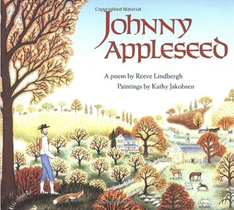
Johnny Appleseed. Reeve Lindbergh. Illustrated by Kathy Jakobsen. Little, Brown Books for Young Readers, 1993. (K-3) Respect, Responsibility, Perseverance.
This is a poetic rendering of the life and times of Johnny Appleseed for young children with charming, detailed folk-art illustrations. It does not hide the fact that John Chapman was a missionary, but that is not the book's focus. His contributions to the frontier with numerous varieties of apples are front and center.
This is a poetic rendering of the life and times of Johnny Appleseed for young children with charming, detailed folk-art illustrations. It does not hide the fact that John Chapman was a missionary, but that is not the book's focus. His contributions to the frontier with numerous varieties of apples are front and center.
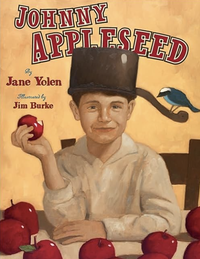
Johnny Appleseed: The Legend and the Truth. Jane Yolen. Illustrated by Jim Burke. HarperCollins, 2011. (2-4) Respect, Responsibility, Perseverance.
Jane Yolen separates fact from fiction with lyrical grace, still honoring the contributions of this American folk hero. Did he wear a pot on his head? (yes) Was he often barefoot? (yes) Did animals often crowd around him as he walked? (probably not..) The gorgeous paintings by Jim Burke add joy and realism.
Jane Yolen separates fact from fiction with lyrical grace, still honoring the contributions of this American folk hero. Did he wear a pot on his head? (yes) Was he often barefoot? (yes) Did animals often crowd around him as he walked? (probably not..) The gorgeous paintings by Jim Burke add joy and realism.
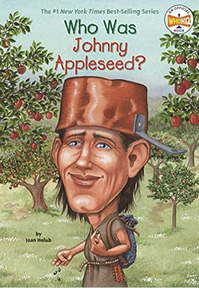
Who Was Johnny Appleseed? Joan Holub. Illustrated by Anna DiVito. Penguin Workshop, 2005. (3-6) Respect, Responsibility, Perseverance.
This fuller biography (112 pages) recounts Johnny's life from his birth in Leominster, Massachusetts, through his father's service in the American Revolution (he fought at Bunker Hill) to his own frontier life. If you have twelve brothers and sisters, you might like to get outside for some peace and quiet! Johnny's activities planting apple seeds (not grafting) contributed to the variety of apples common in the young United States.
This fuller biography (112 pages) recounts Johnny's life from his birth in Leominster, Massachusetts, through his father's service in the American Revolution (he fought at Bunker Hill) to his own frontier life. If you have twelve brothers and sisters, you might like to get outside for some peace and quiet! Johnny's activities planting apple seeds (not grafting) contributed to the variety of apples common in the young United States.
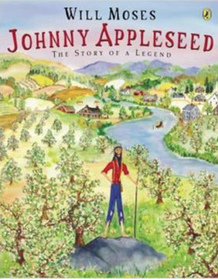
Johnny Appleseed: The Story of a Legend. Will Moses. Philomel Books, 2001. (3-6) Respect, Responsibility, Perseverance.
This picture biography for older children is text-heavy, but with plenty of art alongside the words. The book dives into more details of John Chapman's life, telling several interesting episodes not always included in shorter picture versions—his childhood, his cultivating of bee "skeps," his gift of apple trees to a young boy named David Hunter, and more. Though the author is clear that some of these stories may be apocryphal, the book is written keeping in mind that "it is Johnny's good character that may serve as an even better and stronger beacon to follow" than his orchards of apple trees that marked the way for settlers in the colonial era.
This picture biography for older children is text-heavy, but with plenty of art alongside the words. The book dives into more details of John Chapman's life, telling several interesting episodes not always included in shorter picture versions—his childhood, his cultivating of bee "skeps," his gift of apple trees to a young boy named David Hunter, and more. Though the author is clear that some of these stories may be apocryphal, the book is written keeping in mind that "it is Johnny's good character that may serve as an even better and stronger beacon to follow" than his orchards of apple trees that marked the way for settlers in the colonial era.
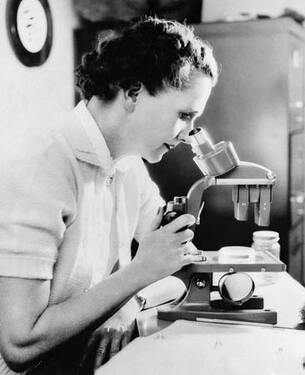
In September, when students begin their studies, they are often torn between “back to school” excitement and the lure of fading summer joys. What better heroine for September than that chronicler of the sea, Rachel Carson! She exemplifies respect for our environment and responsibility toward the world in which we live.
Rachel Carson (1907-1964)
Carson’s childhood love of the sea and all of nature led her to a fruitful career in marine biology and gave our country a poetic and prolific writer on natural history and a champion for the environment. Her three volumes Under the Sea Wind (1941), The Sea Around Us (1950), and At the Edge of the Sea (1953) were histories of the ocean and its sea life. Her lifelong interest in preserving natural wonders made her one of the first environmentalists. In the 1960s, she began to write on the dangers of new chemical pesticides (DDT) being sprayed without regard to the delicate ecosystems they damaged. Her most famous book, Silent Spring, published in 1962 helped launch the environmental movement, and is widely regarded as one of the best volumes of non-fiction published in the twentieth century. Discover Magazine named Silent Spring one of the 25 greatest science books of all time. Carson’s work educates, instills a sense of wonder, and actually led to banning of DDT as pesticide.
In September, as Core Virtues schools focus on “respect and responsibility,” we hope you’ll celebrate this woman who throughout her career exemplified respect for our natural world and care in its stewardship.
Rachel Carson (1907-1964)
Carson’s childhood love of the sea and all of nature led her to a fruitful career in marine biology and gave our country a poetic and prolific writer on natural history and a champion for the environment. Her three volumes Under the Sea Wind (1941), The Sea Around Us (1950), and At the Edge of the Sea (1953) were histories of the ocean and its sea life. Her lifelong interest in preserving natural wonders made her one of the first environmentalists. In the 1960s, she began to write on the dangers of new chemical pesticides (DDT) being sprayed without regard to the delicate ecosystems they damaged. Her most famous book, Silent Spring, published in 1962 helped launch the environmental movement, and is widely regarded as one of the best volumes of non-fiction published in the twentieth century. Discover Magazine named Silent Spring one of the 25 greatest science books of all time. Carson’s work educates, instills a sense of wonder, and actually led to banning of DDT as pesticide.
In September, as Core Virtues schools focus on “respect and responsibility,” we hope you’ll celebrate this woman who throughout her career exemplified respect for our natural world and care in its stewardship.
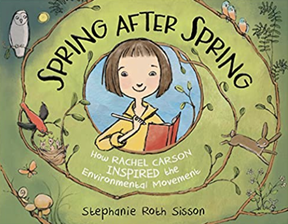
Spring After Spring: How Rachel Carson Inspired the Environmental Movement. Stephanie Roth Sisson. Roaring Book Press, 2018 (K-2)
A young child's introduction to the another child who listened to and celebrated the rhythms of the seasons. This brightly and beautifully illustrated book follows Rachel Carson from the child who listened for nature's songs in spring to the adult biologist who worried about Silent Springs and the effects of pesticides and chemicals on our environment. A hopeful story of caring for our world and working to improve it.
A young child's introduction to the another child who listened to and celebrated the rhythms of the seasons. This brightly and beautifully illustrated book follows Rachel Carson from the child who listened for nature's songs in spring to the adult biologist who worried about Silent Springs and the effects of pesticides and chemicals on our environment. A hopeful story of caring for our world and working to improve it.
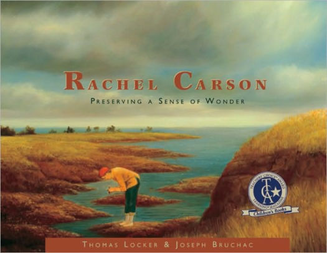
Rachel Carson: Preserving a Sense of Wonder
Joseph Bruchac.
Illustrated by Thomas Locker.
Fulcrum Publishing, 2009. (K-4)
Lyrical text combines with haunting illustrations to bring to life the Pennsylvania childhood of environmental pioneer Rachel Carson. Carson learned birdsong from her youth and loved exploring coastal waters. Her pathbreaking book Silent Spring warned of environmental dangers that could be avoided through better stewardship of the earth.
Joseph Bruchac.
Illustrated by Thomas Locker.
Fulcrum Publishing, 2009. (K-4)
Lyrical text combines with haunting illustrations to bring to life the Pennsylvania childhood of environmental pioneer Rachel Carson. Carson learned birdsong from her youth and loved exploring coastal waters. Her pathbreaking book Silent Spring warned of environmental dangers that could be avoided through better stewardship of the earth.
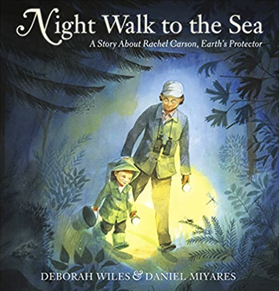
Night Walk to the Sea: A Story About Rachel Carson, Earth's Protector. Deborah Wiles. Illustrated by Daniel Miyares. Schwartz and Wade, 2020. (K-3) Courage, Respect
Five-year-old Roger lives with his Aunt Rachel, and is terrified by a thunderstorm at night. As the storm dies down, the famous naturalist urges him to put on his slicker and rubber boots, and join her for a night walk to the sea. They discover wonders -- among them creatures who produce their own light in a storm (bioluminescence). This is not a book about Carson so much as her observant and reverent attitude toward the wonders of nature -- the perspective that inspired her work. It's also a book about courage and finding our own light in the darkness. Striking illustrations.
Five-year-old Roger lives with his Aunt Rachel, and is terrified by a thunderstorm at night. As the storm dies down, the famous naturalist urges him to put on his slicker and rubber boots, and join her for a night walk to the sea. They discover wonders -- among them creatures who produce their own light in a storm (bioluminescence). This is not a book about Carson so much as her observant and reverent attitude toward the wonders of nature -- the perspective that inspired her work. It's also a book about courage and finding our own light in the darkness. Striking illustrations.
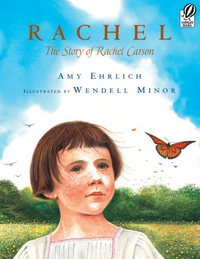
Rachel. The Story of Rachel Carson. Amy Ehrlich.
Illustrated by Wendell Minor. Harcourt Books, 2008. Stewardship, Lives to Learn From (2-5)
Gorgeous illustrations of the natural world highlight this thoughtful biography of Rachel Carson, who from an early age loved writing and nature. As an undergraduate, Rachel intended to become a writer, but changed her major to biology after a particularly intriguing course. Her adult life married her twin passions, and as the author of Silent Spring, Carson became an early champion of the environment, urging caution in the use of pesticides and DDT. The illustrations are stunning and the rich, lyrically told story will inspire young people. (NB: The book needed a better content editor: sentence structure on one page suggests that whales are fish and that plankton density is higher than it is, but our judgment is in favor of the book.)
Illustrated by Wendell Minor. Harcourt Books, 2008. Stewardship, Lives to Learn From (2-5)
Gorgeous illustrations of the natural world highlight this thoughtful biography of Rachel Carson, who from an early age loved writing and nature. As an undergraduate, Rachel intended to become a writer, but changed her major to biology after a particularly intriguing course. Her adult life married her twin passions, and as the author of Silent Spring, Carson became an early champion of the environment, urging caution in the use of pesticides and DDT. The illustrations are stunning and the rich, lyrically told story will inspire young people. (NB: The book needed a better content editor: sentence structure on one page suggests that whales are fish and that plankton density is higher than it is, but our judgment is in favor of the book.)
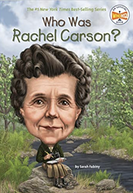
Who Was Rachel Carson? Sarah Fabiny. Illustrated by Dede Putra. Penguin Workshop, 2014. (3-6)
Not so much a morning gathering read-aloud, as deeper background for third to sixth graders on this pioneer of the environmental movement. The "Who Was" series is a reliable staple for young scholars seeking additional understanding of key figures. Though not lyrical, the slender chapter book is clearly written and provides a fuller portrait of Carson's life and work.
Not so much a morning gathering read-aloud, as deeper background for third to sixth graders on this pioneer of the environmental movement. The "Who Was" series is a reliable staple for young scholars seeking additional understanding of key figures. Though not lyrical, the slender chapter book is clearly written and provides a fuller portrait of Carson's life and work.
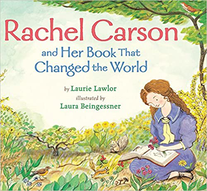
Rachel Carson and Her Book that Changed the World. Laurie Lawlor. Illustrated by Laura Beingessner. Holiday House, 2014. Wonder, Diligence, Stewardship (2-6)
This is a fine introductory biography to a pioneer in environmental science and the author of Silent Spring. As a child exploring Pennsylvania woods, Rachel learned to recognize the call of a yellowthroat and the song of a wood thrush. The family farm constantly fed her curiosity and both parents knew how important education was, sacrificing much to send Rachel to college, where she studied biology. But hard times of the Depression followed and after graduating, Rachel considered herself fortunate to find a job writing for a radio program about sea life. This led to articles for scientific journals, however, and soon her research became well known. She loved writing about nature."Once you are aware of the wonder and beauty of the earth, you will want to learn about it."
This is a fine introductory biography to a pioneer in environmental science and the author of Silent Spring. As a child exploring Pennsylvania woods, Rachel learned to recognize the call of a yellowthroat and the song of a wood thrush. The family farm constantly fed her curiosity and both parents knew how important education was, sacrificing much to send Rachel to college, where she studied biology. But hard times of the Depression followed and after graduating, Rachel considered herself fortunate to find a job writing for a radio program about sea life. This led to articles for scientific journals, however, and soon her research became well known. She loved writing about nature."Once you are aware of the wonder and beauty of the earth, you will want to learn about it."
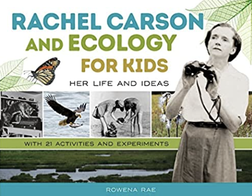
Rachel Carson and Ecology for Kids. Rowena Rae. Chicago Review Press, 2020. 144 pages. (4-6 and teachers too!)
This introductory biography puts the focus on experiments and activities. Rae emphasizes Carson's life long embrace of the wonders of nature and features 21 experiments for kids to do on their own. The text is sometimes chopped up by the suggested activities, but science teachers will probably love this!
This introductory biography puts the focus on experiments and activities. Rae emphasizes Carson's life long embrace of the wonders of nature and features 21 experiments for kids to do on their own. The text is sometimes chopped up by the suggested activities, but science teachers will probably love this!
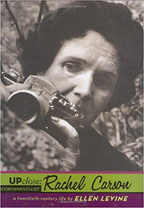
Rachel Carson: A Twentieth-Century Life. Ellen S. Levine.
Viking Juvenile, 2007. (5-8)
This chapter book biography is well written, engaging, and provides middle schoolers with deeper understanding of the many of the challenges faced by Carson as a female scientist in a relatively new field (ecology). Future marine biologists will be inspired by the tenacity of this heroine.
Viking Juvenile, 2007. (5-8)
This chapter book biography is well written, engaging, and provides middle schoolers with deeper understanding of the many of the challenges faced by Carson as a female scientist in a relatively new field (ecology). Future marine biologists will be inspired by the tenacity of this heroine.
Friendship
|
Our friends complete us. They build us up. They broaden our horizons, and make us think new thoughts. Their affection and respect lift our spirits. But they can also challenge us to see our weaknesses.
From Aristotle to modern times, philosophers have recognized friendship (the most intimate exercise of human respect and responsibility) as a uniquely human virtue. This month we're spotlighting friendships in history -- friends, whose unique bond made the world a better place. Would Washington have succeeded without Hamilton? Would the Declaration of Independence been written without John Adams' willingness to charge his friend? Would the Emancipation Proclamation have existed without the Lincoln-Douglass bond? This new series, History's Famous Friendships, will help older children (grades 3-6) appreciate the importance of those they befriend. |
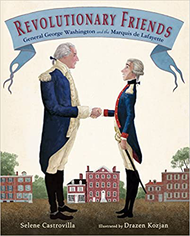
Revolutionary Friends: General Washington and the Marquis de Lafayette. Selene Castrovilla. Illustrations by Drazan Kozjan. Calkins Creek, 2013. (3-5) Friendship
The beautifully illustrated and true story of an unlikely friendship between an eager, young French aristocrat, and the sober judicious General Washington. Excellent sidebars and scrolls for more information. One of the most consequential friendships in history. |
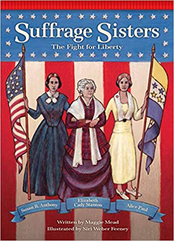
Suffrage Sisters. Maggie Mead. Illustrated by Siri Weber Feeney. Red Chair Press, 2015. (3-5) (on Epic!)
|
Heroic Responsibility
In September we remind children that "responsibility is doing our part for the groups that make us whole." Classroom responsibilities range from simple housekeeping chores to facilitate learning to consistently doing one's homework. Seldom is one's "responsibility" raised to the level of heroism. But there are men and women, our nation's first responders, who, as part of their jobs and vocations, risk their lives for others. In a time of danger, they are rushing in to help as others are rushing out. And that is heroism.
In September we feature not a single hero, but, exemplars of heroic responsibility in action. New York's Bravest looks back to nineteenth-century hero, Mose Humphrey, and the founding of New York firefighters. Our other choices speak specifically to September 11, 2001, the largest terrorist attack in U.S. history, and one that killed nearly 4000 people. That day and for many days after we saw heroic responsibility in action as many risked their lives to save others. The sight of the firefighters, police, and medical teams running towards danger, while half a million others were fleeing, is one that lives in our hearts and memories, and worth passing on to our children. So too is the true story of the Maasai tribe in Kenya that sought to comfort their American brethren. Three new books (the first three below) draw attention to symbols of hope, resilience, and responsibility on this heartbreaking twentieth anniversary of 9-11.
In September we feature not a single hero, but, exemplars of heroic responsibility in action. New York's Bravest looks back to nineteenth-century hero, Mose Humphrey, and the founding of New York firefighters. Our other choices speak specifically to September 11, 2001, the largest terrorist attack in U.S. history, and one that killed nearly 4000 people. That day and for many days after we saw heroic responsibility in action as many risked their lives to save others. The sight of the firefighters, police, and medical teams running towards danger, while half a million others were fleeing, is one that lives in our hearts and memories, and worth passing on to our children. So too is the true story of the Maasai tribe in Kenya that sought to comfort their American brethren. Three new books (the first three below) draw attention to symbols of hope, resilience, and responsibility on this heartbreaking twentieth anniversary of 9-11.
New and Noteworthy
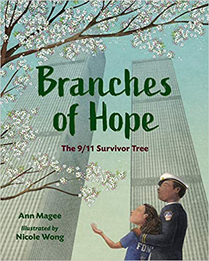
Branches of Hope: The 9/11 Survivor Tree.* Ann Magee. Illustrated by Nicole Wong. Charlesbridge, 2021. (K-3)* Responsibility, Hope, Stewardship; Available on Epic!
From devastation and disaster, branches of hope emerge. The true story of the Callery pear tree at Ground Zero that managed to survive the 9/11 attack: the still blooming tree was discovered in partial growth by NYFD, transplanted, nurtured, and eventually restored to its home near the 9/11 museum. A young girl and her New York Fire Department father witness the devastation, and we follow the tree's growth and renewal (and her family's) as she matures. In the last image, she herself is a New York City Firefighter, and stands vigil near the branches of hope. Simply and artfully told.
From devastation and disaster, branches of hope emerge. The true story of the Callery pear tree at Ground Zero that managed to survive the 9/11 attack: the still blooming tree was discovered in partial growth by NYFD, transplanted, nurtured, and eventually restored to its home near the 9/11 museum. A young girl and her New York Fire Department father witness the devastation, and we follow the tree's growth and renewal (and her family's) as she matures. In the last image, she herself is a New York City Firefighter, and stands vigil near the branches of hope. Simply and artfully told.
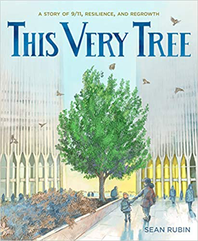
This Very Tree: A Story of 9/11 Resilience and Regrowth. Sean Rubin. Henry Holt and Co., 2021 (K-3)
A pear tree planted near the Twin Towers amazingly survived the devastation of September 11, 2001. This true story is told from the standpoint of the tree, which was scarred and battered but not destroyed. When emergency workers saw that the once-flourishing pear alive, they transferred the struggling tree to the Bronx to nurture it. Ten years later with a full canopy of leaves on its crown, it was restored to its home and planted at the 9/11 Memorial Museum, where it now provides shade and hope. It is still "a battered tree, long suffering and much climbed, held together by strands of wire, but beloved of those who know it." A visible symbol of wounding, recovery, and resilience much needed on this heartbreaking twenty-first anniversary of the Towers collapse. The stewardship and responsibility shown by those who moved, nurtured, and restored the tree is truly remarkable and speaks to the best in us. Beautifully told and illustrated.
A pear tree planted near the Twin Towers amazingly survived the devastation of September 11, 2001. This true story is told from the standpoint of the tree, which was scarred and battered but not destroyed. When emergency workers saw that the once-flourishing pear alive, they transferred the struggling tree to the Bronx to nurture it. Ten years later with a full canopy of leaves on its crown, it was restored to its home and planted at the 9/11 Memorial Museum, where it now provides shade and hope. It is still "a battered tree, long suffering and much climbed, held together by strands of wire, but beloved of those who know it." A visible symbol of wounding, recovery, and resilience much needed on this heartbreaking twenty-first anniversary of the Towers collapse. The stewardship and responsibility shown by those who moved, nurtured, and restored the tree is truly remarkable and speaks to the best in us. Beautifully told and illustrated.
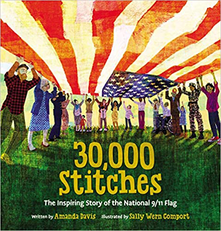
30,000 Stitches. Amanda Davis. Illustrated by Sally Wern Comport. Worthy Kids, 2021. (K-3)
A very touching story of Americans taking responsibility for each other and remembering the best of our national traditions. The enormous but battered American flag that flew over the towers at Ground Zero was put in storage in 2001. There it remained until 2008 when Greensburg, Kansas was hit by a devastating tornado. The "New York Says Thank You" foundation wanted to thank Kansans for their help after 9-11 and lift spirits. They took the flag out of storage, sending it to Greensburg; that led to a nationwide effort to restore the damaged flag using pieces from retired flags from every state. Pieces came from the flag that flew over Fort McHenry when Francis Scott Key wrote the Star Spangled Banner, from the flag that held the remains of Abraham Lincoln after he was shot at Ford's theater, and from many more. Veterans, military veterans, family members of 9/11 victims, and community members all sewed the newly restored flag. The text here is very simple and can be read at K-3. The act is so timeless and meaningful that it should be shared at 4-6 as well.
A very touching story of Americans taking responsibility for each other and remembering the best of our national traditions. The enormous but battered American flag that flew over the towers at Ground Zero was put in storage in 2001. There it remained until 2008 when Greensburg, Kansas was hit by a devastating tornado. The "New York Says Thank You" foundation wanted to thank Kansans for their help after 9-11 and lift spirits. They took the flag out of storage, sending it to Greensburg; that led to a nationwide effort to restore the damaged flag using pieces from retired flags from every state. Pieces came from the flag that flew over Fort McHenry when Francis Scott Key wrote the Star Spangled Banner, from the flag that held the remains of Abraham Lincoln after he was shot at Ford's theater, and from many more. Veterans, military veterans, family members of 9/11 victims, and community members all sewed the newly restored flag. The text here is very simple and can be read at K-3. The act is so timeless and meaningful that it should be shared at 4-6 as well.
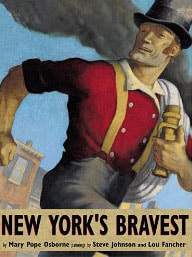
New York’s Bravest Mary Pope Osborne
Dragonfly Books, 2006. (K-3)
This tall tale of Mose Humphrey, a legendary nineteenth century New York firefighter, is dedicated to the memory of the 343 firefighters who lost their lives in rescue efforts on that day. While squarely in the tradition of tall tales, Osborne’s retelling invokes the heroism and courage of those who actually run into harm’s way, while others are fleeing from it. A fitting tribute to those who lost their lives helping the victims of that tragedy.
New York’s Bravest Mary Pope Osborne
Dragonfly Books, 2006. (K-3)
This tall tale of Mose Humphrey, a legendary nineteenth century New York firefighter, is dedicated to the memory of the 343 firefighters who lost their lives in rescue efforts on that day. While squarely in the tradition of tall tales, Osborne’s retelling invokes the heroism and courage of those who actually run into harm’s way, while others are fleeing from it. A fitting tribute to those who lost their lives helping the victims of that tragedy.
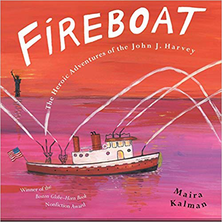
Fireboat. The Heroic Adventures of the John J. Harvey. Maira Kalman. G.P. Putnam's Sons, 2002. (K-2) Heroism, Stewardship.
Very much in the spirit of Mike Mulligan and His Steam Shovel, this is the true story of a fire boat (a boat built to pump water and fight fires on piers) built in 1930, just as the Empire State Building was rising. She was sent to the scrap heap in 1995, the little vessel was reclaimed by friends (investors), who couldn't bear to let her go, and brought her back to life. It's a good thing, because on September 11, 2001, every waterline and water boat in New York City was needed to put out fires in Manhattan. "The nice old boat [who] could NEVER be used to fight a fire" again, everyone said, went back into service doing exactly that. This is a helpful, sideways glance into 9-11 for young children. The focus is less on the horrific attack, than on a brave little vessel that helped to make the city whole again, and on the people who cared for her so well.
Very much in the spirit of Mike Mulligan and His Steam Shovel, this is the true story of a fire boat (a boat built to pump water and fight fires on piers) built in 1930, just as the Empire State Building was rising. She was sent to the scrap heap in 1995, the little vessel was reclaimed by friends (investors), who couldn't bear to let her go, and brought her back to life. It's a good thing, because on September 11, 2001, every waterline and water boat in New York City was needed to put out fires in Manhattan. "The nice old boat [who] could NEVER be used to fight a fire" again, everyone said, went back into service doing exactly that. This is a helpful, sideways glance into 9-11 for young children. The focus is less on the horrific attack, than on a brave little vessel that helped to make the city whole again, and on the people who cared for her so well.
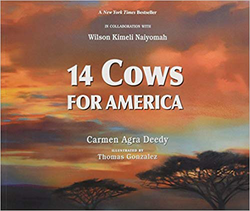
14 Cows for America. Carmen Agra Deedy.
Illustrated by Thomas Gonzalez. In Collaboration with Wilson Kimeli Naiyomah. Peachtree, 2009. (3-6)
The true story of a Maasai warrior tribe in Kenya responding to the horror of 9-11. Kimeli, a Maasai, was studying in New York City at the time of the attack. He returns to Kenya and speaks with his people of the horror and his own wish to ease American suffering by making an offering. "To heal a sorrowing heart, give something that is dear to your own," is the Masai wisdom. "The cow is life." The Masai invite the American ambassador from Nairobi to accept their sacrificial gift of 14 cows to be held in a specially protected herd. Extraordinary art brings the well told story and the Maasai people to life. The verbiage is simple but the concept (of a sacrificial offering) is profound, and for that reason we indicate older students as the audience. (Teachers should pre-read the afterword to understand the full context. A special flag commemorating the gift is on display at the 9-11 Memorial in New York.) This is a touching example of a distant people feeling kinship and responsibility toward the wounded. "Because there is no nation so powerful it cannot be wounded, nor a people so small they cannot offer mighty comfort."
Illustrated by Thomas Gonzalez. In Collaboration with Wilson Kimeli Naiyomah. Peachtree, 2009. (3-6)
The true story of a Maasai warrior tribe in Kenya responding to the horror of 9-11. Kimeli, a Maasai, was studying in New York City at the time of the attack. He returns to Kenya and speaks with his people of the horror and his own wish to ease American suffering by making an offering. "To heal a sorrowing heart, give something that is dear to your own," is the Masai wisdom. "The cow is life." The Masai invite the American ambassador from Nairobi to accept their sacrificial gift of 14 cows to be held in a specially protected herd. Extraordinary art brings the well told story and the Maasai people to life. The verbiage is simple but the concept (of a sacrificial offering) is profound, and for that reason we indicate older students as the audience. (Teachers should pre-read the afterword to understand the full context. A special flag commemorating the gift is on display at the 9-11 Memorial in New York.) This is a touching example of a distant people feeling kinship and responsibility toward the wounded. "Because there is no nation so powerful it cannot be wounded, nor a people so small they cannot offer mighty comfort."
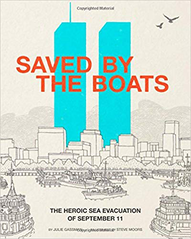
Saved by the Boats: The Heroic Sea Evacuation of September 11.
Julie Gassman. Illustrated by Steve Moors. Capstone Press, 2017.
(3-6) Heroism, Solidarity
Stark gray, white, and blue illustrations give life to the true story of America's own Dunkirk. When the Towers fell on September 11, half a million people had to flee Manhattan, and the Coast Guard called on every boat available to get city-dwellers and survivors of the attacks to safety. This is the dramatic retelling of that harrowing day from one who waited for the sea captains to save her. It is a story of unexpected heroism and America at its finest.
Julie Gassman. Illustrated by Steve Moors. Capstone Press, 2017.
(3-6) Heroism, Solidarity
Stark gray, white, and blue illustrations give life to the true story of America's own Dunkirk. When the Towers fell on September 11, half a million people had to flee Manhattan, and the Coast Guard called on every boat available to get city-dwellers and survivors of the attacks to safety. This is the dramatic retelling of that harrowing day from one who waited for the sea captains to save her. It is a story of unexpected heroism and America at its finest.
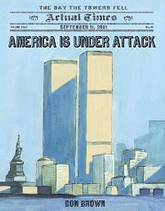
America Is Under Attack. Don Brown.
Flash Point, 2011. (4-6)
This is an honest, sober, and gripping account of September 11 by children’s author Don Brown, who has written on topics ranging from the sinking of the Titanic to Neil Armstrong’s landing on the moon. At 48 pages with evocative water color illustrations, it is a succinct and compelling overview for fourth to sixth graders.
Flash Point, 2011. (4-6)
This is an honest, sober, and gripping account of September 11 by children’s author Don Brown, who has written on topics ranging from the sinking of the Titanic to Neil Armstrong’s landing on the moon. At 48 pages with evocative water color illustrations, it is a succinct and compelling overview for fourth to sixth graders.
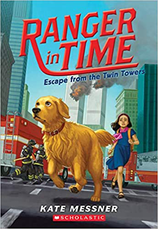
Ranger in Time. Escape from the Twin Towers. Kate Messner. Illustrated by Kelly McMorris. Scholastic Press, 2020. Chapter book. 144 pages. (4-6)
Ranger, a time-traveling rescue dog, is called to New York City on the morning of September 11, to help two children and their mother flee from the flaming towers. Kate Messner deftly and respectfully portrays the tragic event, the heart-stopping escape of the lucky, and also shines a light on those who came to save (not just rescue dogs). This is a very age-appropriate way to introduce fourth to sixth graders to the horror of 9-11. (And kids will fall in love with Ranger, who has other adventures in other books.) The book could be read aloud over the course of a week around September 11.
Ranger, a time-traveling rescue dog, is called to New York City on the morning of September 11, to help two children and their mother flee from the flaming towers. Kate Messner deftly and respectfully portrays the tragic event, the heart-stopping escape of the lucky, and also shines a light on those who came to save (not just rescue dogs). This is a very age-appropriate way to introduce fourth to sixth graders to the horror of 9-11. (And kids will fall in love with Ranger, who has other adventures in other books.) The book could be read aloud over the course of a week around September 11.
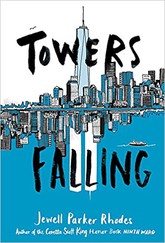
Towers Falling. Jewell Parker Rhodes. Little, Brown & Co. 2016. (4-6) Chapter Book, 228 pgs September Heroes, Friendship
Fifth grader Deja has to start at a new school in Brooklyn when her family moves to a homeless shelter. Life at home is not easy for Deja. Her father is ill with respiratory problems, complicated by PTSD. Deja is also responsible for her younger siblings. She is befriended by Ben and Sabeen, who help her adjust to the new class. When they begin to discuss the events of September 11th, Deja is confused. She has no idea what happened on that day. Ben helps her to understand the events and Deja begins to realize the connection between that and her Dad’s problems. When she confronts her Dad, he admits he tried to keep it from her because it was so terrible. However, talking with her about it helps him to grieve and let go of his guilt for not being able to help his friends that day.
Fifth grader Deja has to start at a new school in Brooklyn when her family moves to a homeless shelter. Life at home is not easy for Deja. Her father is ill with respiratory problems, complicated by PTSD. Deja is also responsible for her younger siblings. She is befriended by Ben and Sabeen, who help her adjust to the new class. When they begin to discuss the events of September 11th, Deja is confused. She has no idea what happened on that day. Ben helps her to understand the events and Deja begins to realize the connection between that and her Dad’s problems. When she confronts her Dad, he admits he tried to keep it from her because it was so terrible. However, talking with her about it helps him to grieve and let go of his guilt for not being able to help his friends that day.
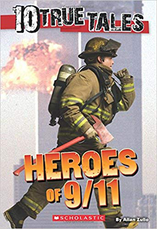
Heroes of 9/11. Ten True Tales. Alan Zullo. Scholastic, 2011. (5-6)
Any one of these 15-20 page stories could be read at circle to Middle Schoolers (this is not a picture book). These are, as the title indicates, true stories of police, firefighters, paramedics, port authority workers, and victims who put others before themselves in the horrific chaos of 9-11. For example, "We Can't Abandon Her!" tells of the FDNY team that assisted a heavy-set elderly woman (Josephine), who'd used all her energy to get from the 70th to 20th floor of the North Tower, but could go no further. Getting her of the building before the tower's inevitable collapse slowed the team's pace and threatened their escape, but in the end, kept them from being killed in the collapse of the tower. Inspiring and harrowing tales.
Any one of these 15-20 page stories could be read at circle to Middle Schoolers (this is not a picture book). These are, as the title indicates, true stories of police, firefighters, paramedics, port authority workers, and victims who put others before themselves in the horrific chaos of 9-11. For example, "We Can't Abandon Her!" tells of the FDNY team that assisted a heavy-set elderly woman (Josephine), who'd used all her energy to get from the 70th to 20th floor of the North Tower, but could go no further. Getting her of the building before the tower's inevitable collapse slowed the team's pace and threatened their escape, but in the end, kept them from being killed in the collapse of the tower. Inspiring and harrowing tales.

